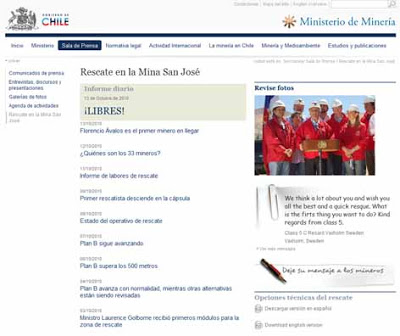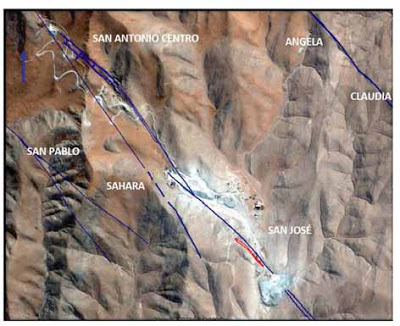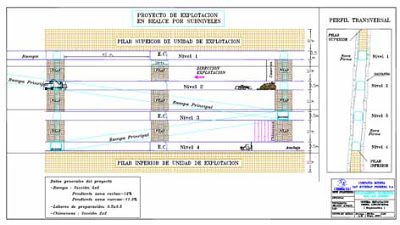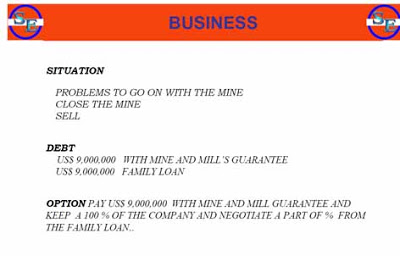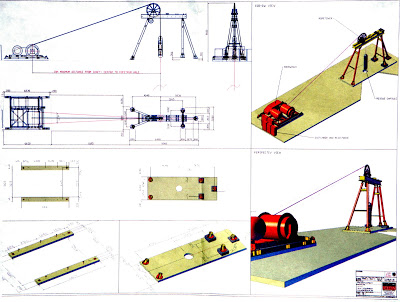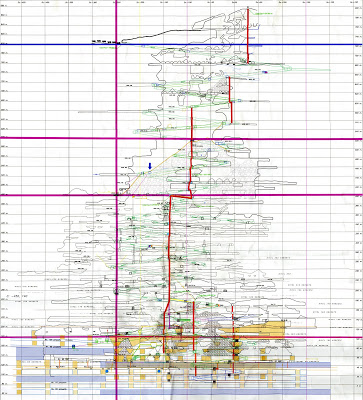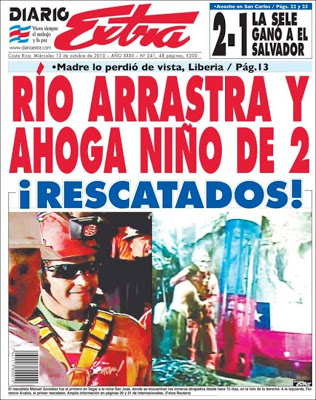Poca información visual la recibida estos días para realizar infografías sobre el rescate de los mineros. Parece increíble la cantidad de gráficos realizados en los medios.
Si alguno de ustedes ha encontrado más referencias visuales oficiales, les agradecería me las enviara.
Página oficial Gobierno de Chile.
Los 33 mineros.
Da un parte diario y existe un PDF con información antigua.
Web específica sobre el rescate, con parte diario hasta el día 13 de octubre.
Nada del proyecto, ni de la cápsula, ni de la perforación.
Muy escasa información visual.
Para la Corporación Nacional del Cobre (CODELCO), Digimapas Chile ha levantado topográficamente la mina San José y alrededores con su Sistema Lidar (Laser Aerotransportado) y cámaras digitales de alta resolución en un tiempo record, siendo realizado el vuelo el día viernes 19 de agosto, para luego procesar y entregar los primeros resultados el lunes 23 de Agosto. Entrego un levantamiento topográfico escala 1:1000 en planimetría, curvas de nivel cada 1m, Ortofotos Digitales con 25cm pixel y nubes de puntos clasificadas en coordenadas locales mina.
La mina San José, NASA.
In early August 2010, Chile’s San José copper and gold mine collapsed, trapping 33 miners underground. Seventeen days later, the miners’ friends and families were overjoyed to learn that the men had survived. However, the good news came with a caveat: rescuing the miners might take months. They would be an isolated group, living in close quarters, in a potentially deadly environment.
Although they work far above—not below—the surface of the Earth, NASA astronauts endure similar isolation and cramped spaces. In a small contribution to the rescue effort, NASA dispatched a four-person team—two physicians, a psychologist, and an engineer—to Chile to provide support. Invited by the Chilean government, NASA administrators hoped that the agency’s expertise in preparing for emergencies in human spaceflight and sustaining life in a hostile environment could provide benefits to the miners.
The San José mine lies north of Copiapó, Chile, in the world’s driest desert, the Atacama. The Advanced Land Imager (ALI) on NASA’s Earth Observing-1 (EO-1) captured this natural-color image of the mine and its surroundings on September 16, 2010. The mine complex appears as an uneven patch of gray in the midst of camel-colored hills devoid of vegetation. Parts of the Atacama have received no precipitation since recordkeeping began.
As of late August 2010, just two 700-meter (2,300-foot) passageways, each about 23 centimeters (9 inches) in diameter, connected the miners with the world above. Through those tubes, rescue workers could pass food, water, medicine, telephone lines, letters between miners and family members, and games to help pass the time. Before their discovery, the miners had fashioned their own dominoes and opened an underground casino to keep up their spirits.
Before their discovery, the miners kept themselves alive by rationing supplies—about a tablespoon of tuna and ounce or two of milk per day. After 17 days, many were close to starvation. James Polk, one of the NASA physicians visiting the site, explained that providing food to people who had been starving is complicated and must be done cautiously. A rapid reintroduction of calories can cause metabolic changes that quickly turn life threatening.
Equally challenging is the emotional ordeal of spending months in a small group in a confined space. Even before they were found, workers had organized themselves into groups and focused on tasks that would contribute to their rescue, including maintaining their section of the mine and the mining equipment, and mapping their location. The NASA team concluded that the miners and their families were setting an example of resilience. The Chilean government, meanwhile, mounted a rescue operation of unprecedented scope.
Las galerías
Informe oficial del Gobierno
Esto este es el esquema del Gobierno de Chile que se encuentra en la red.
Las perforadoras
Informe oficial del Gobierno
Las tomas de perforación.
Informe oficial del Gobierno
El plan de acción inicial
Informe oficial del Gobierno
La jaula de rescate.
Informe oficial del Gobierno
La jaula la construyó ASMAR (los astilleros de Chile), pero en su página no hay nada.
El diseño sería de CODELCO (Corporación Nacional del Cobre), donde tampoco hay nada.
Companía minera de San Esteban
Informe minas, enero 2009
Características de la construcción.
Companía en ruina.
Informe minas, enero 2009
El sistema de polea
Fotografía que pasó Reuters, pero se desconoce el origen.
No está en la web del Gobierno ni en la de la minería.
diagram of the pulley system that will be used to raise the 33 miners individually from the tunnel of the San Jose mine where they have been trapped for weeks is seen at San Jose mine near Copiapo city October 11, 2010. Chilean rescuers on Saturday finished drilling an escape shaft for 33 miners trapped deep underground after a cave-in over two months ago. REUTERS/Handout
Está firmado por: ÖSTU-STETTIN , que realizó el sistema de elevación.
En su web no hay nada.
Headquarter
ÖSTU-STETTIN
Hoch- und Tiefbau GmbH
Münzenbergstraße 38
8700 Leoben
Austria
Tel.: +43 3842 42523
Fax: +43 3842 42523-133
E-Mail: leoben@oestu-stettin.at
www.oestu-stettin.at
La mina San José y el dispositivo en superficie
De Reuters, parece que la foto la hizo un ‘freelance’.
Tampoco se sabe su origen.
A map of the copper and gold mine where 33 miners are trapped in an accident in August is seen at San Jose mine near Copiapo city October 11, 2010. Rescue workers finished reinforcing an escape shaft on Monday for the trapped miners that should help avoid a last-minute disaster, setting the stage for their evacuation and an end to a two-month ordeal that gripped the world. REUTERS/Stringer
La cápsula de rescate diseñada por la Marina de Chile.
La pasó Reuters, mencionando a la Armada Chilena como el origen.
Pero en la página de la Armada no hay nada.
ASMAR la presentó el 15 de septiembre de 2010.
Edificio Rapa Nui
Prat # 856, Piso 13
Valparaíso, Chile
Mesa Central:
Tel.: (56-32) 226 0000 / Fax: (56-32) 226 0157-8
ASMAR es una Empresa del Estado de Administración Autónoma, del área de la industria naval y de la defensa, cuya actividad principal es satisfacer eficientemente las necesidades de reparaciones, carenas y construcciones de las unidades de la Armada de Chile, y efectuar reparaciones, carenas y construcciones de naves y artefactos navales para terceros nacionales y extranjeros.
Plano de la mina.
Me lo pasan desde la Tercera de Chile.
Te adjunto la fotografía del plano que hemos utilizado.
FUENTE: Compañía Minera San Esteban Primera S.A.
Título del plano: «Perfil longitudinal Mina San José Primera»
Fecha: Junio 2010
Escala: 1/1000
No tiene página digital.
En InfoMine está la ficha de la empresa. No hay ninguna información al respecto del rescate.
Compañía Minera San Esteban Primera S.A.
Gerente : Sr. Marcelo Kemeny Fuller.
Dirección : Fidel Oteiza 1921 Of. 806 Providencia
F: 2254651
Fax : 2238880 2254648
Fax : (52)212636(Copiapó) 2254630



